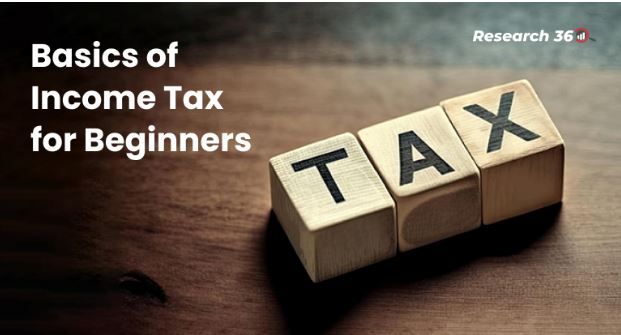The Basics of Income Tax for Beginners

Whether you're a salaried individual, a business owner, or someone with various sources of income, understanding the basics of taxation is very important. However, the Income Tax Act of 1961 can be quite complex and challenging to understand, especially if you’re a first-time taxpayer.
Fortunately, that’s exactly what we are going to look at in this article. Here are some of the income tax basics that you need to know as someone new to the Indian direct taxation system.
Previous Year
The term "previous year" in the context of income tax refers to the financial year that precedes the assessment year. In India, a financial year lasts for 12 months, starting from the 1st of April of the year to the 31st of March of the succeeding year. For instance, the 12-month period starting from 1st April 2022 to 31st March 2023 is an example of a financial year in India.
Assessment Year
The term ‘assessment year’ in the context of income tax refers to the financial year immediately following the previous year.
For example, if the previous year was 1st April 2022 to 31st March 2023, then the assessment year would be 1st April 2023 to 31st March 2024.
The assessment year is the year in which you determine and pay taxes on the income earned during the previous year.
Heads of Income
According to the Income Tax Act, the income you earn is classified into one of five different categories depending on its nature. As a taxpayer, these five heads are among the most important income tax basics you need to be aware of. Here is a detailed overview of each of these categories.
Salaries
The income you earn by way of employment in an organisation is classified under the heading ‘salaries’. Wages, bonuses, pensions, commissions, perquisites, allowances, and other monetary benefits you receive for rendering your services to an organisation as an employee are also included under this head of income.
House Property
The income you earn by letting your property out for rent is classified under ‘house property’. Fortunately, the Income Tax Act of 1961 has several provisions that allow you to deduct taxes and other expenses you incur in connection with your let-out property. This allows you to reduce your rental income and, consequently, the taxes you need to pay.
Profits and Gains from Business or Profession
The income you earn from trade, other business activities or by rendering professional services is classified under ‘profits and gains from business or profession’. The various expenses you incur in connection with your business or profession can be deducted from your income to reduce your tax liability.
Capital Gains
The profits you earn from the sale of tangible and intangible assets are classified as ‘capital gains’. The asset could be anything from land and buildings to shares and other financial instruments. Capital gains are further subclassified into two categories - long-term capital gains and short-term capital gains, depending on how long you hold the asset before selling it.
Other Sources
The income that cannot be classified under any of the above four heads is categorised as ‘other sources’. It includes income from savings accounts, fixed deposits and lottery winnings, among others.
Tax Deductions
As a taxpayer trying to understand the basics of taxation, you must know and be aware of the various tax deductions that you can claim using the provisions of the Income Tax Act of 1961. If used appropriately, these tax deductions can help lower your tax liability significantly. Here is a quick overview of some of the common deductions available under the act.
Standard Deduction
The Income Tax Act of 1961, provides a standard deduction of Rs. 50,000 to all salaried individuals. Claiming this deduction reduces your taxable income and, consequently, your tax liability.
Deductions under Chapter VI A
Chapter VI A of the Income Tax Act encompasses 16 different sections, offering deductions for certain specific expenses and investments you make. The most popular section under Chapter VI A is Section 80C, which lets you claim up to Rs. 1.5 lakh per financial year as deductions if you invest in certain investment options.
Tax Regimes
The Income Tax Act of 1961 gives you the freedom to choose how you want to be taxed. Currently, you can select between two tax regimes - the old tax regime or the new tax regime.
Old Income Tax Regime
Under this regime, you can avail of all the available deductions and exemptions offered by the Income Tax Act. However, the basic taxes tend to be slightly higher compared to the new regime. The tax rates under the old regime for the financial year 2023-2024 are as follows.
Total Taxable Income | Income Tax Rates | ||
|---|---|---|---|
Individuals less than 60 years of age | Individuals between the ages of 60 and 80 (Senior Citizens) | Individuals above the age of 80 (Super Senior Citizens) | |
Up to Rs. 2.5 lakh | NIL | NIL | NIL |
Above Rs. 2.5 lakh to Rs. 3 lakh | 5% | NIL | NIL |
Above Rs. 3 lakh to Rs. 5 lakh | 5% | 5% | NIL |
Above Rs. 5 lakh to Rs. 10 lakh | 20% | 20% | 20% |
Above Rs. 10 lakh | 30% | 30% | 30% |
New Income Tax Regime
Under this regime, the basic taxes are lower, but you cannot avail of any of the available deductions and exemptions except the standard deduction. The tax rates under the new regime for the financial year 2023-2024 are as follows.
Total Taxable Income | Income Tax Rates |
|---|---|
Up to Rs. 3 lakh | NIL |
Above Rs. 3 lakh to Rs. 6 lakh | 5% |
Above Rs. 6 lakh to Rs. 9 lakh | 10% |
Above Rs. 9 lakh to Rs. 12 lakh | 15% |
Above Rs. 12 lakh to Rs. 15 lakh | 20% |
Above Rs. 15 lakh | 30% |
Income Tax Return
An income tax return (ITR) is a document that details the various sources of income you earned and the deductions you claimed for the previous year. It also includes details of the taxes you owe and have paid to the government.
The ITR must be filed with the Income Tax Department if your total income exceeds the basic exemption limit applicable to you as per the Income Tax Act of 1961. The due date for filing the return varies depending on your category and type of income.
Tax Deducted at Source (TDS)
Being a taxpayer, having basic knowledge of TDS is crucial. TDS stands for Tax Deducted at Source. It is a system where tax is deducted by the payer at the time of making certain specified payments, such as salary, interest and rent. The deducted tax is then deposited with the Income Tax Department on behalf of the payee.
Conclusion
With this, you must now have a good grasp of the basics of income tax. Remember, understanding the basics of income tax can help you effectively manage your taxes and ensure compliance with the law.

















